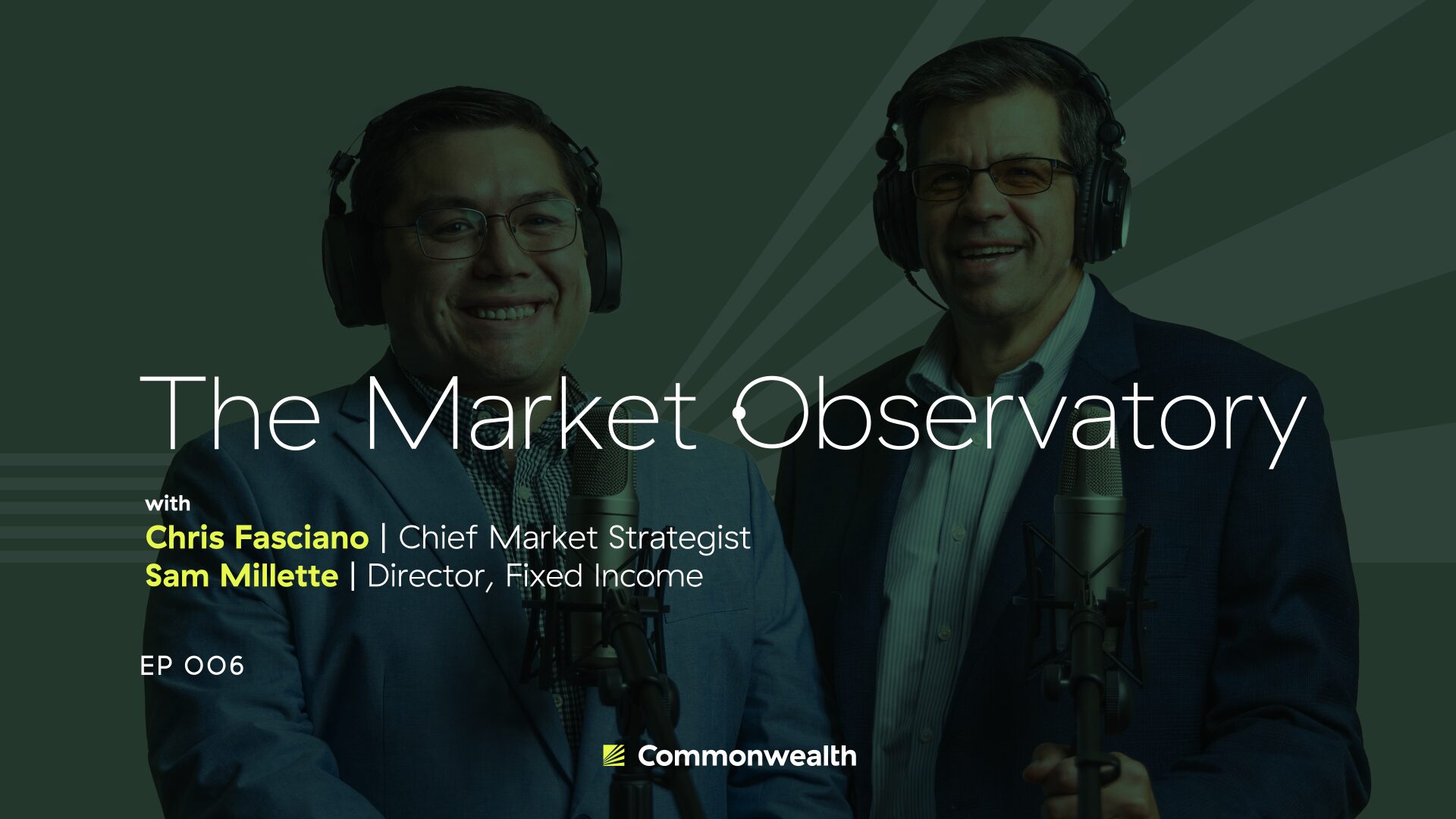In this month’s Market Observatory episode, Sam Millette and I discuss the dominating news story of the year: tariffs and trade policy. Uncertainty has weighed on markets and investors, and the on-again, off-again nature of these policies continues to change the range of outcomes for the economy and corporate earnings.
Commonwealth
Is It Time for Investors to Play the Long Game?
During periods of market volatility and declines, investors get concerned. They question their long-term objectives and whether they have more risk in their portfolios than they can tolerate. These are reasonable thoughts to have at times like these.
Looking at the Economic Data and Volatility in the Bond Market
Last week, the S&P 500 was up 5.7%, the strongest week for the market since November 2023. The Nasdaq rose 7.3%, which was the best week for that index since November 2022. The rally was a result of President Trump’s announcement that he was pausing reciprocal tariffs for 90 days. And while there was no relief for China and the back-and-forth escalation between the two countries, markets latched onto the good news and rallied after a tough couple of months for equity investors.
Tariffs Shock Economy and Markets
The markets are in the middle of a historic decline. Not so much in the magnitude—while we are approaching a bear market, these happen fairly regularly—but in the speed of the drop. We have rarely, if ever, seen this kind of a sudden decline, especially from close to record levels. People are nervous, of course, and understandably so. But that makes it even more important to take a step back and understand how we got here because that will inform where we are going.
Putting the Market Sell-Off into Perspective
At the start of last week, the S&P 500 rallied three days in a row, with investors believing that the tariffs announced on Wednesday would be targeted. But with increasing expectations comes the potential for disappointment. On April 2, the much-anticipated tariff announcements arrived—and investors did not like the news. President Trump announced 10 percent tariffs across the board on all imports from all other countries, excluding Canada and Mexico. Had that been the extent of it, the market’s expectations would most likely have been met. But it also included tariffs on countries identified as bad actors when it comes to trade, which included 34 percent tariffs on China, 24 percent on Japan, and 20 percent on the EU.
Market Thoughts for April 2025 [Video]
March was a tough month for U.S. stocks, as all three major indices were down for the month and quarter. Bonds performed better, as falling interest rates supported prices, and developed and emerging markets both ended the quarter positively. Hiring and inflation also improved, and the solid economic backdrop should keep driving earnings growth. Despite this, we continue to face uncertainty—including tariff concerns and weakening consumer confidence.

![The Market Observatory: Tariffs and Trade Policy [Audio]](https://blog.commonwealth.com/hubfs/Market-Observatory_Ep-006_Horizontal_THUMBNAIL.png)









![Market Thoughts for April 2025 [Video]](https://blog.commonwealth.com/hubfs/Market-Thoughts-April-2025_V01_20250401.00_00_06_07.Still037.png)

 Olivia has joined Riverstone Wealth Partners providing knowledge gained from her 15 plus years in management. Olivia has provided services within the financial industry, mortgage industry, and in the non-profit sector. Olivia thrives on providing stellar customer service, accomplishing all goals set before her, and doing the right thing. Olivia’s degree in Business Management allowed her to take on roles that ultimately led her to Riverstone Wealth Partners. Olivia is currently pursuing another degree with an emphasizes in Human Resources, which she has learned over time… is her passion!
Olivia has joined Riverstone Wealth Partners providing knowledge gained from her 15 plus years in management. Olivia has provided services within the financial industry, mortgage industry, and in the non-profit sector. Olivia thrives on providing stellar customer service, accomplishing all goals set before her, and doing the right thing. Olivia’s degree in Business Management allowed her to take on roles that ultimately led her to Riverstone Wealth Partners. Olivia is currently pursuing another degree with an emphasizes in Human Resources, which she has learned over time… is her passion!



 Director of Operations
Director of Operations


 Ashley has been working in the customer service field since she started her first job at age 16. For the past ten years she worked in an office setting handling accounts payable and receivable as well as some receptionist work. She is very excited to learn more about the investment field.
Ashley has been working in the customer service field since she started her first job at age 16. For the past ten years she worked in an office setting handling accounts payable and receivable as well as some receptionist work. She is very excited to learn more about the investment field. Alec joined Riverstone after starting out his post college career on the operations side of an international logistics company working as an account executive. Graduating with a BA in Economics from the University of Illinois at Urbana-Champaign, he quickly developed a strong interest in the financial world. A lifetime resident of the Chicagoland area, Alec is an avid fan of his hometown sports teams. He is also an enthusiast of outdoor activities like fishing, camping, and hiking whenever possible.
Alec joined Riverstone after starting out his post college career on the operations side of an international logistics company working as an account executive. Graduating with a BA in Economics from the University of Illinois at Urbana-Champaign, he quickly developed a strong interest in the financial world. A lifetime resident of the Chicagoland area, Alec is an avid fan of his hometown sports teams. He is also an enthusiast of outdoor activities like fishing, camping, and hiking whenever possible. Carol has a wide variety of experiences and has worked mainly with not-for-profit organizations. She spent 20 years in fundraising and 15 years teaching in the Illinois school system while she raised her younger children. Carol lives in Sugar Grove with her husband, Ron, and their Golden Retriever, Charley. She has four children and two grandchildren. When she’s not working, Carol enjoys spending time with friends and family, running, fishing, bible study, and watching her grandchildren play sports.
Carol has a wide variety of experiences and has worked mainly with not-for-profit organizations. She spent 20 years in fundraising and 15 years teaching in the Illinois school system while she raised her younger children. Carol lives in Sugar Grove with her husband, Ron, and their Golden Retriever, Charley. She has four children and two grandchildren. When she’s not working, Carol enjoys spending time with friends and family, running, fishing, bible study, and watching her grandchildren play sports. Wealth Advisor
Wealth Advisor Wealth Advisor / Registered Principal
Wealth Advisor / Registered Principal Wealth Advisor
Wealth Advisor Wealth Advisor / Registered Principal
Wealth Advisor / Registered Principal Wealth Advisor
Wealth Advisor Wealth Advisor Assistant
Wealth Advisor Assistant Registered Relationship Assistant
Registered Relationship Assistant